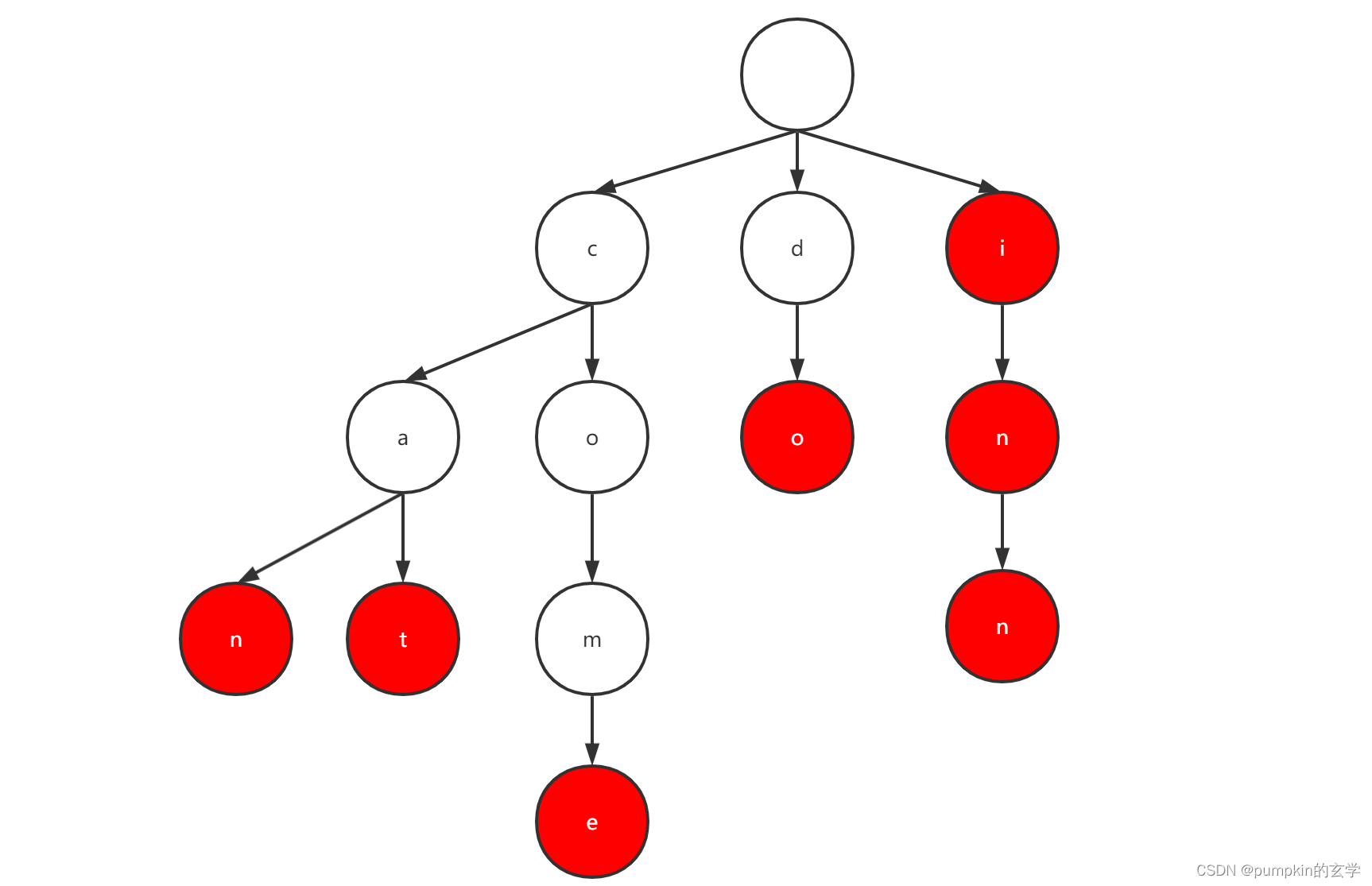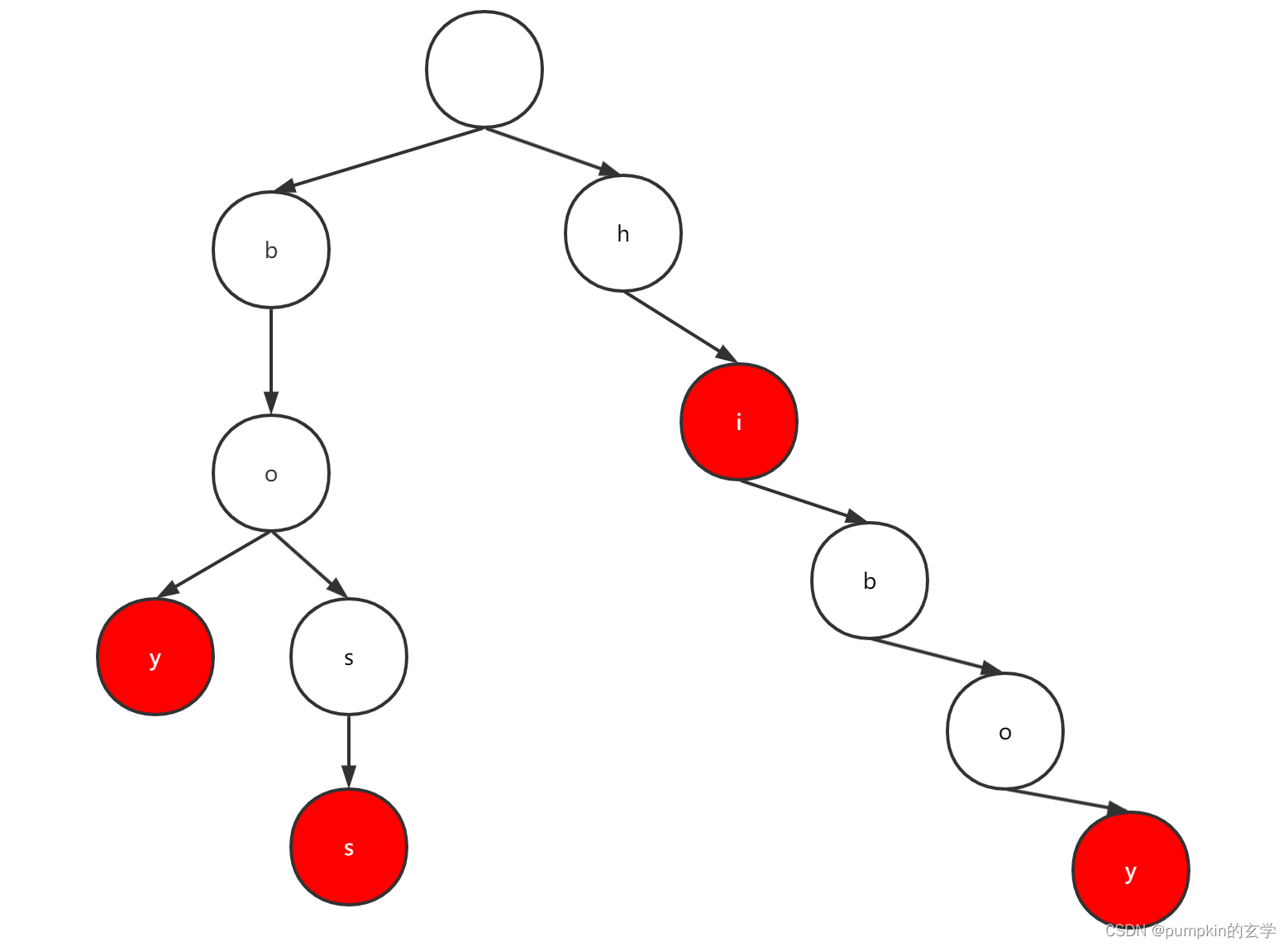前缀树介绍,定义,图文详解分析——Java/Kotlin双版本代码
前缀树
前缀树,又称作字典树,用一个树状的数据结构储存字典中的所有单词。
列,一个包含can、cat、come、do、i、in、inn的前缀树如下图所示:

- 前缀树是一个多叉树,一个节点可能存在多个节点。
- 除根节点外,每个节点表示一个字符串的一个字符,整个字符串由前缀树的路径进行表示。
- 字符串在前缀树的路径并不一定全部都是终止于叶节点,比如
in对应的则是字符串inn的一部分。
前缀树的实现
接下来设计一颗前缀树PrefixTree,其包含如下的操作。
insert,在前缀树中添加一个字符串。search,查找,如果该前缀树中存在该字符串,则返回true。startWith,查找字符串前缀,如果前缀树中存在包含该字符串的前缀,则返回true,否则返回false。matchingStartWith,查找所有包含该前缀的字符串,返回前缀树中所有包含该前缀的字符串,如果不存在则返回null。
首先定义前缀树的数据结构,注意这里我们只考虑实现小写英文字母(具体可以根据业务逻辑调整),因为小写英文字母只有26个,所以我们可以将其放到一个容量为26的数组之中去。数组中第一个元素则是对应a的节点,第二个元素则是对应b的节点,依次往下。需要说明的是,不需要专门一个字段表示当前节点的字符,因为可以根据其在父节点对应的位置,从而得知对应的字符信息。
另外我们需要一个boolean类型的字段,去判断该节点的路径对应的字符串是否是一个完整的字符。
综上,数据结构可以定义为如下所示:
kotlin
class PrefixTree {private val root = Node()class Node {val childNode = Array(26) { null }var isWord = false}
}
java
class PrefixTree {private Node root =new Node();class Node {Node[] childNode = new Node[26];boolean isWord = false;}}
insert函数实现
我们添加boy、boss、hiboy、hi四个单词,具体分析一下前缀树添加的过程:
- 添加
boy,逐个添加字母b、o和y对应的节点,并将最后一个字母y对应的节点的isWord标记为true - 添加
boss,此时前两个字母b和o对应的节点之前已经创建出来,因此只需要创建两个对应s的节点,并将第2个s对应节点的字段isWord标记为true - 添加
hiboy,虽然之前有添加过b、o、y三个单词,但是其并不是hiboy的前缀,所以需要为hiboy每个单词创建节点,并将最后的节点置为true - 添加
hi,由于hi为前缀,所以不需要创建节点添加,只需要将i对应的节点的isWord置为ture即可

所以,插入的代码可以做如下的实现
kotlin
fun insert(word: String) {var localRoot = rootword.toCharArray().forEach { char ->val index = char - 'a'if (localRoot.childNode[index] == null) {localRoot.childNode[index] = Node()}localRoot = localRoot.childNode[index]!!}localRoot.isWord = true}
java
public void insert(String world){Node localRoot = root;for (char c :world.toCharArray()){int index = c - 'a';if (localRoot.childNode[index]==null){localRoot.childNode[index] = new Node();}localRoot = localRoot.childNode[index]}localRoot.isWord = true;}
search函数实现
这个思考起来比较简单一点,直接从根节点开始查找,如果要查找的字符串对应的字符在根节点中不存在,则直接返回false,如果存在则前往该节点,在该节点查找是否存在与字符串对应的第二个字符的节点,没有返回false,如果存在则继续往下查找,直到查找完最后一个字符,最终判断如果isWord为true则返回true,否则则返回false。
所以代码如下所示:
kotlin
fun search(word: String): Boolean {var localRoot = rootword.toCharArray().forEach { char: Char ->val index = char - 'a'if (localRoot.childNode[index] != null) {localRoot = localRoot.childNode[index]!!} else {return false}}return localRoot.isWord}
java
public boolean search(String world){Node localRoot = root;for (char c :world.toCharArray()){int index = c - 'a';if (localRoot.childNode[index]!=null){localRoot = localRoot.childNode[index];}else {return false;}}return localRoot.isWord;}
startWith函数实现
函数startWith和search不同,只要前缀树中存在以输入的前缀开头的单词就应该返回true。因此,函数startWith的返回值和函数search不同之外,其他代码是一样的。
kotlin
fun startWith(word: String): Boolean {var localRoot = rootword.toCharArray().forEach { char: Char ->val index = char - 'a'if (localRoot.childNode[index] != null) {localRoot = localRoot.childNode[index]!!} else {return false}}return true}
java
public boolean startWith(String world){Node localRoot = root;for (char c :world.toCharArray()){int index = c - 'a';if (localRoot.childNode[index]!=null){localRoot = localRoot.childNode[index];}else {return false;}}return true;}
matchingStartWith函数实现
该函数要求返回所有匹配到前缀的单词。
所以分为以下两个步骤:
- 匹配前缀,如果匹配不到直接返回null
- 匹配到之后,在该前缀的节点进行深度优先搜索,将遍历到的所有单词全部加入集合进行返回
所以代码如下所示:
kotlin
fun matchingStartWith(word: String): List? {val wordResultPre = StringBuilder()var localRoot = rootword.toCharArray().forEach { char: Char ->val index = char - 'a'if (localRoot.childNode[index] != null) {wordResultPre.append(char)localRoot = localRoot.childNode[index]!!} else {return null}}//深度优先搜索 所有的剩余单词val result = ArrayList()dfs(localRoot, StringBuilder(),wordResultPre,result)return result}private fun dfs(node: Node, str: StringBuilder, wordResultPre: StringBuilder, result: ArrayList) {val childNodes = node.childNodefor (index in childNodes.indices) {val childNode = childNodes[index]if (childNode != null) {str.append(('a' + index).toChar())if (childNode.isWord) {result.add(wordResultPre.toString() + str.toString())}dfs(childNode,str, wordResultPre, result)}}}
java
public List matchingStartWith(String world){StringBuilder wordResultPre = new StringBuilder();Node localRoot = root;for (char c :world.toCharArray()){int index = c - 'a';if (localRoot.childNode[index]!=null){wordResultPre.append(c);localRoot = localRoot.childNode[index];}else {return null;}}//深度优先搜索 所有的剩余单词List result =new ArrayList<>();dfs(localRoot,new StringBuilder(),wordResultPre,result);return result;}private void dfs(Node node, StringBuilder stringBuilder, StringBuilder wordResultPre, List result) {Node[] childNodes = node.childNode;for (int i =0 ;iNode childNode = childNodes[i];if (childNode!=null){stringBuilder.append('a'+i);if (childNode.isWord){result.add(wordResultPre.toString()+stringBuilder.toString());}dfs(childNode,stringBuilder,wordResultPre,result);}}}
前缀树应用
题目
输入一个包含n个单词的数组,可以把它们编码成一个字符串和n个下标。例如,单词数组["time","me","bell"]可以编码成一个字符串"time#bell#",然后这些单词就可以通过下标[0,2,5]得到。对于每个下标,都可以从编码得到的字符串中相应的位置开始扫描,直到遇到’#'字符前所经过的子字符串为单词数组中的一个单词。所以如果输入的是字符串数组["time","me","bell"],那么编码之后最短的字符串是"time#bell#",长度是10。
分析
题目的目标是得到最短的编码,因此,如果一个单词是另一个单词的后缀,那么单词在编码字符串中就不需要单独出现,这是因为单词可以通过在单词中偏移下标得到。
所以我们很容易想到前缀树,但是题目是关于字符串的后缀。所以,我们可以反转字符串,之后使用前缀树。
根据题目信息,我们不需要关心每个单词,只需要遍历每个叶子节点对应的字符串的长度,然后加在一起即可。但是注意,字符串和字符串之间存在#,所以需要对长度进行额外+1。
总体来说使用深度优先搜索,代码参考如下:
public void minLength(String [] words){PrefixTree.Node node = build(words);int [] total = {0};dfs(node,1,total);}private void dfs(PrefixTree.Node node, int length, int[] total) {boolean isLeaf = true;for (PrefixTree.Node childNode : node.getChildNode()) {if (childNode != null) {isLeaf = false;dfs(childNode, length + 1, total);}}if (isLeaf) {total[0] += length;}}
🙆♀️。欢迎技术探讨噢!
